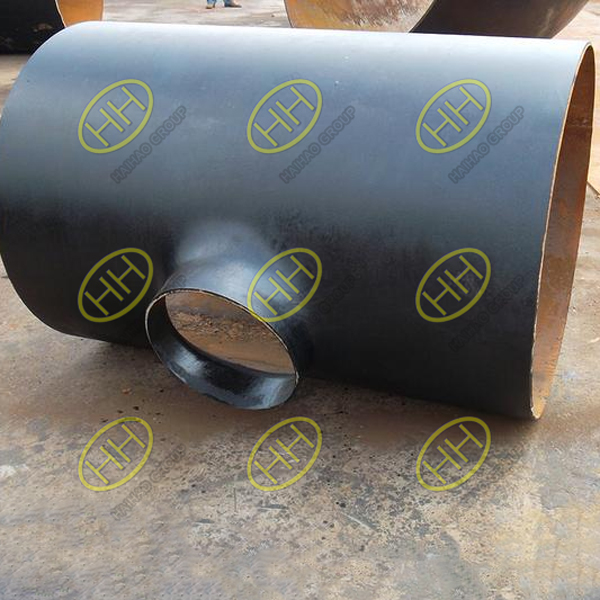Introduction to ASME B16.9 A234 WPB 34″ x 24″ butt weld reducing tee
The ASME B16.9 A234 WPB butt weld reducing tees are a critical component used in piping systems where a branch is required to connect to a larger main pipe, allowing for a reduction in the pipe size. This specific tee has dimensions of 34″ x 24″, making it suitable for large-scale industrial applications, particularly in oil and gas, petrochemical, and power plant systems. It follows the ASME B16.9 standard, which defines the requirements for butt weld fittings, including tees, reducers, elbows, and more.
Key Features and Advantages of ASME B16.9 A234 WPB Butt Weld Reducing Tee
1.Material Specification – ASTM A234 WPB: The material for this reducing tee is made of A234 WPB, a specification for wrought carbon steel fittings used in pressure piping systems. It offers excellent strength and resistance to corrosion, making it ideal for high-pressure applications. WPB is one of the most common materials for carbon steel piping components, especially in industries such as oil and gas, where durability and reliability are crucial.
2.Large Dimensions (34″ x 24″): The specific dimensions of 34″ x 24″ reflect the large-scale nature of the application this reducing tee is designed for. Larger sizes are often required for industrial pipelines where higher flow capacities are needed to move large volumes of fluid or gas, such as in power generation or petrochemical refineries.

ASME B16.9 A234 WPB Butt Weld Reducing Tee
3.Butt Weld Design: The butt weld design is a key feature of the ASME B16.9 standard. Butt weld fittings provide a strong and leak-proof connection between pipes, ensuring the integrity of the pipeline under high pressure and temperature. This design is favored in applications where strength, durability, and security are critical. The butt weld process involves welding the fitting directly to the pipe, creating a seamless and durable joint.
4.Welded Manufacturing Process: Since the product is produced using the welding process, the two ends of the tee are welded directly to the pipes. This method ensures a strong connection capable of handling high pressures and temperatures, as it eliminates the potential for leaks that can occur with flanged or threaded connections.
Given the size and importance of the ASME B16.9 Butt Weld Reducing Tee A234 WPB in high-pressure applications, it undergoes a series of non-destructive testing (NDT) procedures to ensure its integrity. Non-destructive testing is critical to identify any potential defects without damaging the material, ensuring that the final product meets the required standards for safety and performance.
Common NDT methods used for this product include:
Ultrasonic Testing (UT): Used to detect internal defects such as cracks, voids, and inclusions. This method uses high-frequency sound waves to inspect the material’s integrity.
Magnetic Particle Inspection (MPI): This is particularly useful for detecting surface and near-surface defects. Magnetic particles are applied to the surface, and the magnetic field is used to detect any interruptions caused by cracks or defects.
X-ray Inspection: This method is used to detect internal defects, ensuring the welds and overall structure of the tee are free from defects that could compromise the system’s integrity.
At Haihao Group, we ensure that all of our pipe fittings, including the reducing tees, meet the highest standards for quality and performance. Our team is committed to delivering products that exceed client expectations, providing the necessary assurance for a safe and reliable piping system. If you require more information or have specific needs for your pipeline project, please don’t hesitate to contact us.

